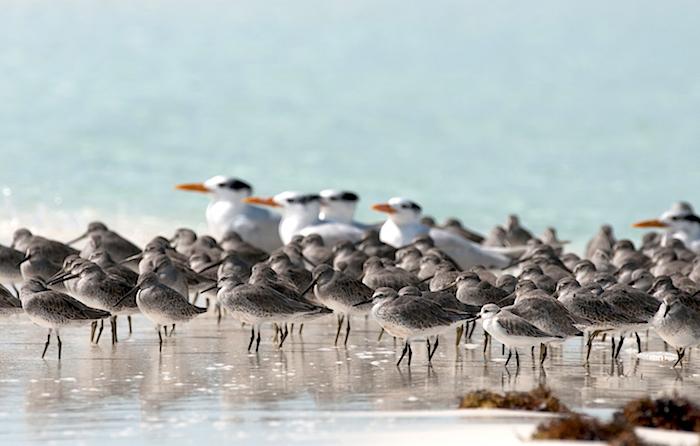
Joulter Cays National Park in the Bahamas, just designated in August, is a magnet for shorebirds/Walker Goulder, National Audubon Society
It looks like I have a new national park to add to my “must bird” list. Earlier this month the Bahamas unveiled Joulter Cays National Park, and it is truly a park for the birds. The christening of the national park is the result of several years of work by the National Audubon Society, the Bahamas National Trust, and the Bahamian government.
Conservation biologists are keenly aware of the perils faced by endangered migratory birds in the winter. I know some biologists who seem to fret more in the winter when “their” birds are not in sight where they can be monitored than during the nerve-wracking breeding season. For many hobbyist birders, this isn’t always the case. Our summer residents disappear in the fall and we then think about the winter arrivals until the familiar breeders start heading back in April. Out of sight might mean out of mind, but it certainly doesn’t mean out of danger. That’s where Joulter Cays comes in.
Several of North America’s threatened birds call the Bahamas home for the winter, or use the islands as a crucial migratory stopover. Our rarest songbird, the Kirtland’s Warbler, nests primarily in a few counties in Michigan and winters on a few islands in the Bahamas. Research conducted by Audubon determined that 10 percent of the Atlantic Coast population of the endangered Piping Plover winter on the 114,000 acres that is now Joulter Cays National Park. The threatened Red Knot uses the area in winter and in migration.
The primary reason for creating the park is protection of the habitat for the birds, but keeping it available to recreational activities is also important to the Bahamas. The biggest threats to habitat in the islands is development and sand mining, both of which permanently destroy beach habitat necessary for shorebirds. The creation of the park should put an end to those threats on that particular land.
It’s not clear yet how a birder might best visit this new national park, but I imagine some boat tours will be forthcoming. Lawrence Glinton, president of Bahamas National Trust said, “The park also has tremendous ecotourism potential and can generate significant revenue from bird based tourism. BNT and Audubon are presently developing a program that will allow local residents to take full advantage of these exciting new opportunities.”
The opportunity to visit some of my shorebird friends in the winter is certainly appealing to me, so hopefully I’ll be making a report from the field sometime soon.



Comments
Is there a site containing any images of this proposed park?
Google the park name and filter the search for "images." There are quite a few shots.